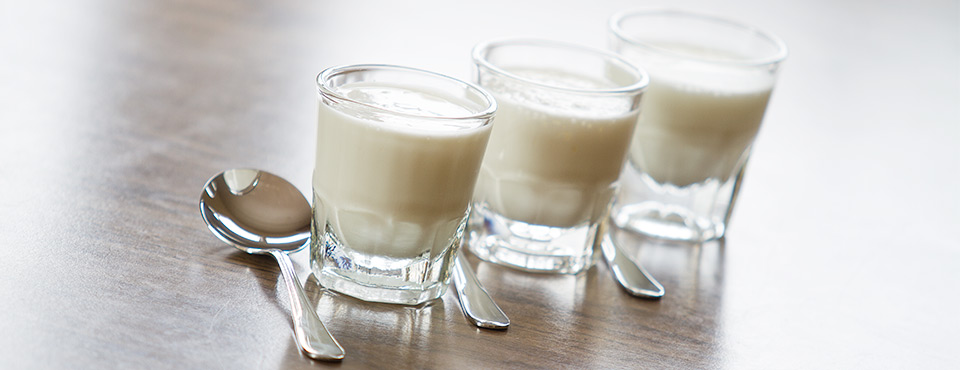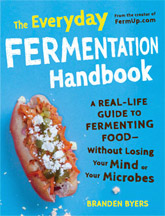Taste testing three heirloom yogurts: Bulgarian, Matsoni and Filmjölk. How do these thermophilic (made in yogurt maker) and mesophilic (made at room temperature) yogurts compare?
An important caveat to remember when comparing homemade yogurts is that they are homemade. Given that homemade yogurt, and heirloom yogurts in general, are not absolutely consistent from batch to batch or home to home, this comparison is based on three batches of yogurt brewed in Madison, Wisconsin within three days of tasting using organic whole milk. Your results may vary depending on fermentation temperature, length of fermentation and overall health of the dominant bacteria in your starter culture. With that aside, if fermenting these cultures within the general guidelines for each yogurt, you should end up with similar tasting profiles.
What makes heirloom yogurt different?
While I could go on about the nuances and complexities inherent in heirloom yogurt (much of which are highly subjective), the key differences between heirloom yogurt and commercial yogurt are diversity and “re-culturability.”
If you make yogurt with direct-set yogurt starters, or plain commercial yogurts from the grocery store, you will end up with a yogurt that consistently produces the same results (as long as you consistently follow the same procedure) batch after batch. That is, as long as you use a new direct-set starter or commercial yogurt for each batch. If, instead, you try to make yogurt as it has been made for hundreds of years, wherein you inoculate your ensuing batches with your previous batches of yogurt (a.k.a. back-slopping), you may experience similar results for the first few batches, but eventually (my experience has been anywhere from 6 to 12 batches), your yogurt will no longer resemble the yogurt you started with.
Even if you are using sanitized equipment, temperature probes and a thermostat controlled incubator with accurate temperature regulation down to 1°F/C, the isolated microbial cultures in these commercial starters will alter unpredictably over time.
Direct-set versus heirloom starter cultures
So what is the difference? Simply put, a direct-set starter culture is like a one-night stand: instant gratification with no commitment. Heirloom yogurts are like pets: they provide years of enjoyment but you must feed them regularly. Treat either of them as something that they are not and you might get away with it a few times but eventually you will be disappointed.
Simply put, a direct-set starter culture is like a one-night stand...
Direct-set starter cultures, and the commercial/homemade yogurts produced by them, are comprised of specific and isolated strains of bacteria that microbiologists and yogurt producers have deemed appropriate for accurate and reproducible results. Rightfully so, yogurt manufacturers do not want to produce large stainless steel vats full of inconsistent yogurt nor do many consumers wish to play a guessing game as to what will be in a cup of yogurt from purchase to purchase.
Heirloom yogurts are like pets: they provide years of enjoyment but you must feed them regularly.
Heirloom yogurts have taken a more natural evolution. Instead of microbiologists deciding within the last 100 years which microbes make for the best batches of yogurt, the microbial communities have evolved alongside milk and humans for hundreds of years. These are not isolated strains, but vibrant communities of living organisms which humans have presumably selected by conscious choice or mere happenstance.
It is the complexity of these heirloom yogurt varietals that maintains the microbial balance from batch to batch. I’m certain the taste of heirloom varietals does change over time, but this change is much subtler and spans centuries as opposed to weeks. If the culture is properly cared for, it is possible to maintain heirloom yogurt cultures that are passable from one human generation to the next. They truly are heirlooms as their title suggests.
The comparison: Bulgarian, Matsoni and Filmjölk yogurts
These are only three of the many heirloom yogurt varietals available throughout the world. Thanks to the growing popularity of fermented foods and DIY yogurt making, it is now possible to purchase many of these heirloom starter cultures online. No longer must you rely on knowing someone with a culture brought back from some distant land or the potential inconsistency of a culture shipped from a stranger in one of the many online culture sharing forums (although I have had good results receiving kefir grains in the past using these means). But remember, the more you try, the more you will have to care for and keep alive.
Bulgarian Heirloom Yogurt: This culture most closely resembles store-bought yogurt. This should be no surprise considering Bulgarian yogurt was the original sample examined and dissected by microbiologists to ascertain the “key” bacteria responsible for the traditionally taste of yogurt. This is a thermophilic (heat loving) yogurt that requires incubation in the range of 110-115°F (43-46°C) and is usually made with cow’s milk.
Matsoni Heirloom Yogurt: Also known as Caspian Sea Yogurt, this culture originates from Georgia and the surrounding caucasus region. This is a mesophilic yogurt that ferments well at temperatures between 70-78°F (21-26°C).
Filmjölk Heirloom Yogurt: You can call this Nordic yogurt Fil for short. This is also a mesophilic yogurt that ferments well on a kitchen countertop at temperatures between 70-78°F (21-26°C).
The Yogurt tasting results
I tasted six samples; three at room temperature and three straight from the refrigerator. The samples that were left at room temperature for 45 minutes expressed a lot more flavor and smell but ultimately were relatively similar to the cold version. When it comes to smell, my vocabulary for milk and yogurt is still rather limited so they all smelled to varying degrees like milk and cheese. Lastly, I find that the thickness of each yogurt fluctuates slightly from batch to batch so I will not comparing viscosity today.
Bulgarian: The Bulgarian yogurt was the tartest of the group with a light mouthfeel. There was also a mellow barley/oat taste that rounded out the flavor.
Matsoni: The matsoni yogurt was almost buttery with a nutty/vanilla bean flavor. Once warm, it took on an almost sweet almond like flavor.
Filmjölk: The Filmjölk yogurt had the most pronounced cheese flavor, especially so when at room temperature. There was also slight tartness in the finish.
Conclusion
Overall, these yogurts each possess a distinct flavor profile and are all quite enjoyable. I eat all of them on a daily basis but considering their differences, I assume some people would gravitate more toward one or the other. If I had to pick a daily favorite, I would chose the Bulgarian yogurt whereas my wife prefers either of the mesophilic ones. If you have never tried an heirloom yogurt before, I recommend trying one for yourself. They are easy to make and taste great.
Share you results and let me know which yogurts you prefer. If you find your results do vary in a way that you don’t think that they should, let me know and I will do my best to help you troubleshoot the situation.
Where to buy
A quick Google search will show a multitude of online retailers selling these starters. My favorite place to find new yogurt cultures is Cultures for Health. They have competitive prices, inexpensive shipping and high quality freeze-dried yogurt starters. Plus, if you follow this link for yogurt starter cultures, you will be helping to further support Fermup.com.


 Listen Now
Listen Now 
